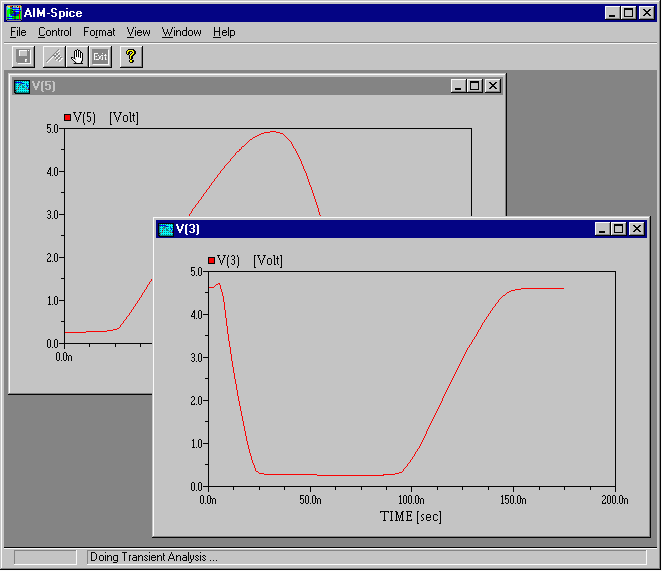Introduction
SPICE is the most commonly used analog circuit simulator
today and is enormously important for the electronics industry. SPICE is a
general purpose analog simulator which contains models for most circuit
elements and can handle complex nonlinear circuits. The simulator can
calculate dc operating points, perform transient analyses, locate poles and
zeros for different kinds of transfer functions, find the small signal
frequency response, small signal transfer functions, small signal
sensitivities, and perform Fourier, noise, and distortion analyses.
The simulator was developed at the University of California, Berkeley, and
was first released in 1972. Many scientists at Berkeley and other
institutions contributed to the development and improvement in subsequent
versions of SPICE. In 1975, Nagel described the next major release of SPICE,
called SPICE2. The core of the program still remained intact, even after
many improvements and additions. These included improved device models,
numerical techniques, and user interfaces. The last major release, SPICE3,
came in 1985 with a conversion of the source code from FORTRAN to the C
programming language. The Berkeley version of SPICE is a public domain
program, but since the late 1970s a number of companies have released
commercial versions of SPICE, providing further improvements in user
support, in user interfaces, and, in certain cases, also in models and in
simulation convergence.
IM-Spice is
capable of displaying graphically the results of a simulation in progress, a
feature that allows the operator to terminate a run based on instant
information on intermediate simulation results. The development of AIM-Spice
was motivated by the need of a more user friendly interface, and as a
vehicle for the new set of advanced device models for circuit simulation
developed by our group.
AIM-Spice Features
-
AIM-Spice runs on the following platforms: Microsoft Windows,
Linux, MacOS, iOS, Android, Windows Phone.
-
Uses the Berkeley SPICE version 3.E1 as the kernel.
-
Displays simulation results in progress by plotting
graphically circuit variables during a run.
-
Includes advanced new models for a number of semiconductor
devices.
-
Includes a graphical post processor, AIM-Postprocessor.
Simulation Control
In AIM-Spice the operator has complete control during a
simulation. Before a simulation starts, the circuit variables to be
monitored during the run are selected, and AIM-Spice will display
graphically the progress of these variables during the simulation. The
figure below shows a typical snapshot of an AIM-Spice simulation in
progress.

New Semiconductor Device Models
New advanced models for the following semiconductor devices are implemented in
AIM-Spice:
- Heterostructure Diode
- Heterojunction Bipolar Transistor (HBT)
- MOSFETs. The following MOSFET models are included:
- Level 1,2, 3 and 6 from Berkeley
- BSIM1
- BSIM2
- BSIM3 versions
- BSIM3 SOI
- BSIM4 versions.
- GaAs MESFETs and HFETs.
- Amorphous Silicon Thin Film Transistors (a-Si TFTs)
- Polysilicon Thin Film Transistors (poly-Si TFTs)
- Tunnel Field-Effect Transistors (TFETs)
The FET models are all based on versions of the unified charge control model (UCCM),
which describes the channel charge in Field Effect Transistors (FETs) in the above and
below threshold regimes, using one analytical expression.
Extensions to Berkely SPICE:
- Temperature sweep analysis
- Support for libraries
- Libraries containing thousands of devices
- Support for parameters in the netlist
- Support for parameters in subcircuit calls
- Polynomial dependent sources (POLY sources)
- Global nodes
- BSIM3 versions 2 and 3 ((MOSFET levels 13 and 14)
BSIM4 versions 1.0, 2.0, 2.1, 3.0 and 4.0.
- Support for extended commands:
.connect
.defwave
.extract
.global
.lib
.param
.plot
- Enhanced commenting features (comment blocks and comments within continuation lines)
AIM-Postprocessor
A graphic postprocessor is included in the AIM-Spice simulator package
for the Microsoft Windows platform.
Although AIM-Spice has facilities to plot circuit variables graphically,
AIM-Postprocessor has a much more powerful plotting engine including the following
features:
- Plotting of sums and differences, derivatives, integrals, and mathematical functions of
circuit variables and creating hard copies.
- FFT (Fast Fourier Transform)
- Cursors to select numerical values and to calculate differences between variables.
- Import of experimental data.
- Hard copies
More Information
More information on AIM-Spice can be found in the following two books:
- T. A. Fjeldly, T. Ytterdal, and M. Shur, Introduction to Device Modeling and Circuit
Simulation, John Wiley & Sons, New York, (1998), ISBN 0-471-15778-3.
- K. Lee, M. Shur, T. A. Fjeldly, and T. Ytterdal, Semiconductor Device Modeling for
VLSI, Prentice Hall, Englewood Cliffs, NJ (1993), ISBN 0-13-805656-0. This book is in
the Prentice Hall "Available on Demand program". YOU CAN ONLY ORDER IT THROUGH A
COLLEGE BOOKSTORE of your choice.When ordering it from Prentice hall, please specify TITLE
CODE : 805655.
|
